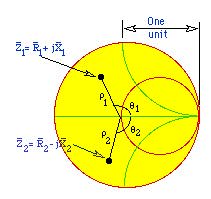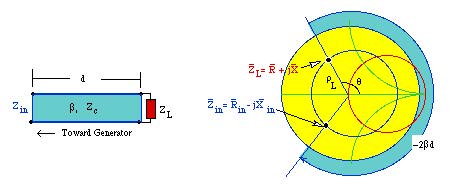
Note: Upper part of the Smith chart is positive reactance, lower part is negative reactance.
Read the magnitude of the reflection coefficient r1 or r2 The angle from the horizontal axis toward the load is the angle of the load reflection coefficient, q. This can be read from the angular divisions of the Smith chart.
Note: The distance from the center of the Smith chart to the R=0.0 circle is one unit irrespective of the size of the Smith chart. (To find the magnitude of the reflection coefficient, measure it's length with a ruler and scale it with respect to the radius of the Smith chart).
Note: The angle for the negative reactance can be read as a negative angle, i.e., q2=-112o, or q2=360o-112o=248o.

Note: You can not read reflection coefficient at this point. For the IMPEDANCE Chart, the reflection coefficient is always determined from the impedance.
Note: the magnitude of the reflection coefficient is still determined by the load impedance. The presence of the line effects only the phase angle. And the angle changes by q-2bd). 2bd is subtracted from the angle q.
To find the input impedance and the reflection coefficient at the input of the line, draw a circle with a radius equal to rL centered at the origin of the Smith chart. Move through an angle -2bd . This means that you move in the clockwise direction an angle equal to -2bd beginning from the location of q (toward the generator on the Smith chart) At the intersection point of the rL circle and the -2bl line, read the input impedance. The angle read with respect to the horizontal axis is the phase angle of the reflection coefficient at the input of the line.
Note: In addition to the angular division of the Smith, there is also an angular scale which is labelled as wavelengths toward the generator (or toward load). This is more general than calculating the angle -2bd in degrees or radians. This is so general that it applies to any arbitrary transmission line.
If the length of the line is equal to (l/2)l,, then -2bl.= -2p. This is consistent with the result that the impedance repeats itself with every half wavelength.